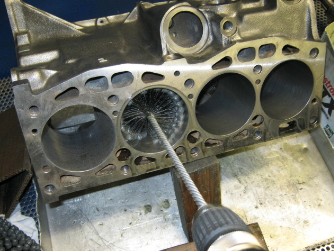By Jim Tapp
 For years, engine builders have been honing cylinders with a coarse stone followed by a finishing stone. Then ring materials changed, requiring an additional very fine finishing stone to follow. Now current technology demands an added step to create an even cleaner, burr-free finish.
For years, engine builders have been honing cylinders with a coarse stone followed by a finishing stone. Then ring materials changed, requiring an additional very fine finishing stone to follow. Now current technology demands an added step to create an even cleaner, burr-free finish.
However, even with these conventional honing techniques, peaks of folded and torn metal still remain in bores. No amount of washing with an ordinary brush could remove this material. A too-rough bore results in scuffing and rapid wear of components, poor ring sealing, reduced component life and oil consumption. This is especially a problem with today’s thinner, low-tension piston rings. Piston ring manufacturers now lap the rings to replicate seating. With the use of ultra-finish hones, cylinder wall technology has also been elevated to pre-seated quality.
Confusion about this hone tool arises from the many different names given to the same tool and process; Plateau hones, soft hones, whisker hones and ultra-finish hones all do the same thing. Without enlarging the bore, they sweep across the surface to remove jagged peaks, folded and torn material.
The ultra-finish hone consists of a mono-filament strand that is extrude-molded with a fine abrasive material. This abrasive filament can be mounted to different types of holders, but usage and performance is identical. This product is available in holders and brush-type tools, for use with many of the current hones – portable or automatic. Tooling suppliers also offer a selection of small diameter ultra-finish hones that can be used with a simple, pistol-grip drill.
During use, the ultra-finish hone will travel at a light load pressure, closely simulating rpm at which the cylinder was initially honed. Rotation can be reversed when using a portable hone. Its purpose is to slightly deburr the edges of and to remove folded and partially severed material from the cylinder face, the area piston rings actually ride on. The ultra-finish hone is not designed to clean out grooves established by coarse honing or to deglaze cylinders. By design, the ultra-finish hone is used to prepare the cylinder bore for immediate ring seal with little, if any, material loss from cylinder wall on initial engine start-up. This minimizes ring abrasion and broken cylinder wall material migrating to our oiling system. Now we have a near perfect situation, a lapped ring passing over a fully prepared cylinder.
CAUTION: Don’t over do the cylinder with a ultra-finish hone. Sixteen to eighteen strokes are the maximum. Strokes beyond this can produce a finish too smooth to retain adequate lubrication for wear resistance and infinite cylinder pressure sealing.
For engine builders who are not yet equipped with a profilometer, here is a slick little test that illustrates the effect of ultra-finish honing. After finishing a cylinder with conventional finishing techniques, dry the cylinder surface area. Take a cotton ball and lightly contact the cylinder rotating around 2 or 3 surface inches. Cotton strands can be seen hanging, snagged on the wall. Now use the ultra-finish hone on the cylinder with liberal amounts of honing oil. Repeat the cotton ball test after using the ultra-finish hone and see the difference. A very noticeable difference should occur with the number of cotton strands, almost no retention! Not a very scientific test, but a good indication of what type of finish has been established in that cylinder. This same finish can be achieved in many other applications, valve guides, lifter bores and piston pin bushings.
Adding this step in your honing procedure will finalize the plateau finish. Rings will seal without abrasion, compression is maximized, and better oil control will lower emissions. Ends scuffing and scratching, prevents premature wear of valve guides, stems, lifters, etc. You now have the tools and knowledge, add the ultra-finish hones to your honing process to completely finish the job.
Source: Goodson Tools













